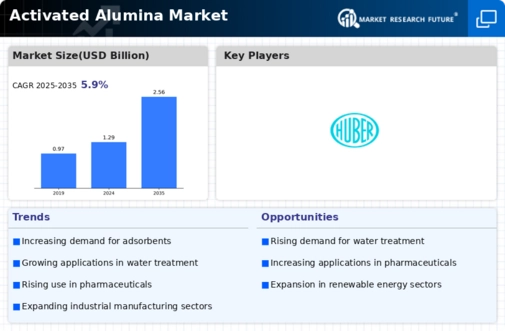Top Industry Leaders in the Activated Alumina Market
 Activated alumina, the unassuming hero of countless purification processes, quietly powers a multi-billion dollar market. But beneath the steady ascent lies a fiercely competitive landscape where established giants and nimble innovators grapple for a bigger slice of the adsorbent pie.
Activated alumina, the unassuming hero of countless purification processes, quietly powers a multi-billion dollar market. But beneath the steady ascent lies a fiercely competitive landscape where established giants and nimble innovators grapple for a bigger slice of the adsorbent pie.
Strategies Segregating the Competition:
-
Innovation Crucible: Leading players like Sumitomo Chemical, Huber Engineered Materials, and BASF are pushing the boundaries of material science. Sumitomo's SAC series boasts exceptional adsorption capacity for high-purity applications, while Huber's SpheriSorb® line offers unmatched regeneration efficiency for cost-conscious users. -
Application Spotlight Lens: Companies are strategically honing in on specific end-use applications. AluChem Inc. dominates the water treatment sector with its advanced fluoride removal adsorbents, while Sorbead India caters to the petrochemical industry with its desiccants optimized for refinery processes. -
Geographic Expansion Trail: Established players are venturing beyond their traditional territories. Huber's recent acquisition of a Chinese producer strengthens its foothold in Asia Pacific, while BASF eyes expansion into Latin America through strategic partnerships. -
Sustainability Cauldron: The green wave is washing over the market, with companies like Hengye Inc. developing activated aluminas from recycled materials and bio-based precursors. This resonates with environmentally conscious consumers and brands aiming to reduce their waste footprint.
Factors Holding the Adsorption Crown:
-
Adsorption Performance Spectrum: Superior capacity, selectivity, regeneration efficiency, and resistance to chemical and thermal degradation are key determinants of market share. High-performance aluminas command premium prices and attract customers in demanding industries. -
Cost-Effectiveness Concoction: Affordability plays a crucial role, especially in bulk applications like water treatment and industrial gas purification. Striking the balance between cost and performance is a delicate dance for manufacturers. -
Regulatory Compliance Compass: Stringent regulations regarding heavy metals, volatile organic compounds (VOCs), and contact with food and pharmaceuticals are shaping the market. Companies with compliant aluminas gain a competitive edge, particularly in sensitive sectors. -
Supply Chain Alchemy: A robust and reliable supply chain is critical for ensuring timely delivery and avoiding raw material shortages and price fluctuations. Strategic partnerships with logistics providers and raw material suppliers are essential for success.
Key Players:
BASF SE (Germany), Honeywell International Inc (US), Sumitomo Chemical Co (Japan), Porocel Industries LLC (US), Dynamic Adsorbents Inc (US), Axens SA (US), Shandong Zhongxin New Material Technology Co., Ltd (China), Huber Engineered Materials (US), Jiangxi Sanxin Hi-Tech Ceramics Co., Ltd (China), Sialca Industries (India), and AGC Chemicals Pvt. Ltd (India) are the key players in the global activated alumina market.
Recent Developments:
July 2023: Several companies showcase innovative activated alumina applications at the CHEMTECH World Expo, sparking interest from diverse industries like food and beverage processing and medical device manufacturing.
September 2023: The FDA approval for the activated alumina-based drug delivery system opens up a new market segment with high growth potential and unlocks further possibilities for personalized medicine.
October 2023: The proposed EU regulations raise concerns within the industry, with companies lobbying for revisions and alternative solutions that don't stifle innovation.
November 2023: Despite regulatory uncertainties, the overall market sentiment remains positive, with continued investments in research and development for advanced activated alumina technologies with improved functionality and environmental sustainability

